Physical Address
304 North Cardinal St.
Dorchester Center, MA 02124
Physical Address
304 North Cardinal St.
Dorchester Center, MA 02124

Before you hit the trail solo, discover the crucial safety secrets that could mean the difference between adventure and disaster.
While solo hiking might seem risky, it’s actually one of the most rewarding ways to connect with nature when you’re properly prepared. You’ll discover a sense of freedom and self-reliance that group hiking simply can’t match. The key isn’t avoiding solo adventures—it’s knowing how to plan smart and stay safe. Whether you’re considering your first solo trek or looking to refine your approach, these essential strategies will transform your confidence and ensure you’re ready for whatever the trail throws your way.
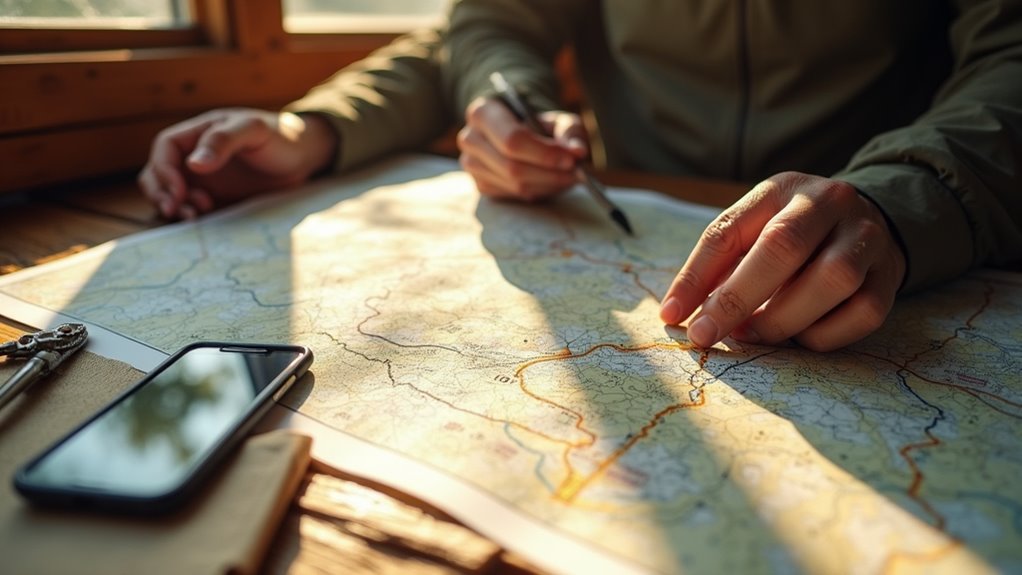
Before you lace up your boots and hit the trail, you’ll want to thoroughly research your chosen route and let someone know your plans. Study trail maps, elevation profiles, and recent conditions through hiking apps or park websites. Check weather forecasts and trail closures that could affect your journey.
Create a detailed itinerary including your starting point, planned route, rest stops, and expected return time. Share this information with a trusted friend or family member who’ll know when to worry if you don’t check in. Include emergency contact numbers and local ranger station details.
Don’t forget to research water sources, restroom facilities, and potential hazards like wildlife or challenging terrain sections. This preparation isn’t paranoia—it’s smart hiking that keeps you safe and confident on solo adventures. Consider planning future hikes where you can enjoy the outdoors with loved ones, as family camping creates unforgettable bonding experiences and shared adventures.
Once you’ve mapped out your route and shared your plans, you’ll need to equip yourself with the right safety and navigation tools. Start with a reliable GPS device or smartphone with offline maps downloaded beforehand. Don’t rely solely on technology—pack a physical map and compass as backups.
Your safety kit should include a first aid kit, whistle, headlamp with extra batteries, and emergency shelter like a space blanket. Consider carrying a personal locator beacon for remote areas. A multi-tool proves invaluable for unexpected situations.
If you’re hiking in bear country, pack bear spray and know how to use it. Water purification tablets or a portable filter ensure you won’t run out of clean drinking water during emergencies.
Just as hikers should research their gear thoroughly before heading out, it’s crucial to avoid common mistakes when making any major outdoor equipment purchases.
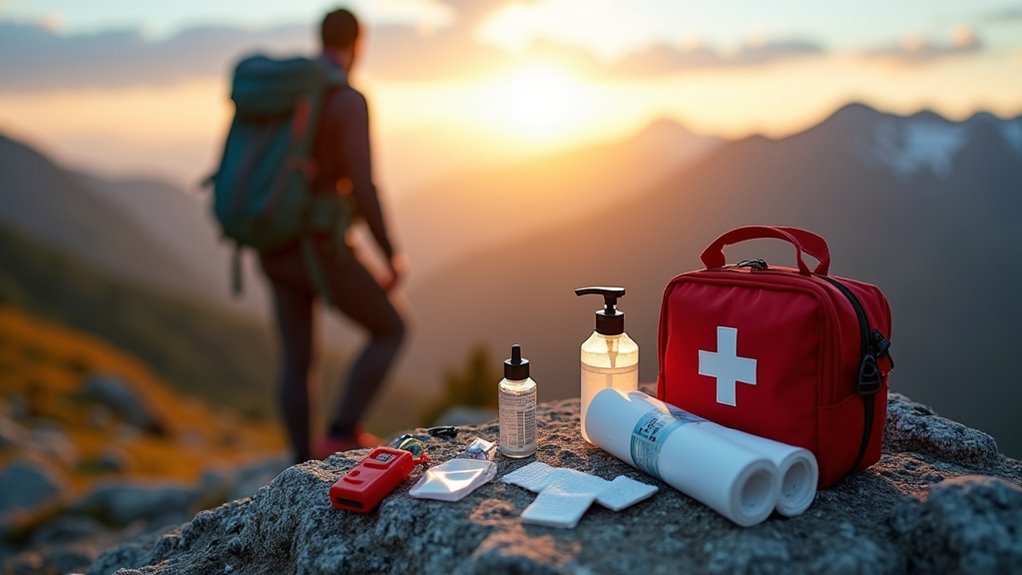
While carrying the right gear is essential, knowing how to use it effectively can mean the difference between a minor setback and a life-threatening situation. You’ll want to learn basic wound care, including cleaning cuts and applying bandages properly.
Practice treating sprains, recognizing hypothermia symptoms, and managing dehydration before you hit the trail.
Take a wilderness first aid course if possible – it’s worth every penny. Know how to signal for help using your whistle, mirror, or phone’s emergency features.
Create an action plan for common scenarios: getting lost, injury, or severe weather. Practice these skills at home so they’re second nature.
Just as with any outdoor activity like boating, preparation and knowledge of emergency procedures are crucial for solo hikers venturing into wilderness areas.
Since weather conditions can change rapidly in the wilderness, your clothing choices will directly impact your comfort and safety on the trail. You’ll want to master the three-layer system: a moisture-wicking base layer, an insulating middle layer, and a waterproof outer shell. This approach lets you adjust quickly as temperatures fluctuate throughout your hike.
Always pack extra layers, even on sunny days. Mountain weather’s unpredictable, and hypothermia can strike faster than you’d expect.
Choose synthetic materials or merino wool over cotton, which retains moisture and loses insulation when wet.
Don’t forget to consider bringing a portable camping toilet for extended hikes where bathroom facilities aren’t available along the trail.
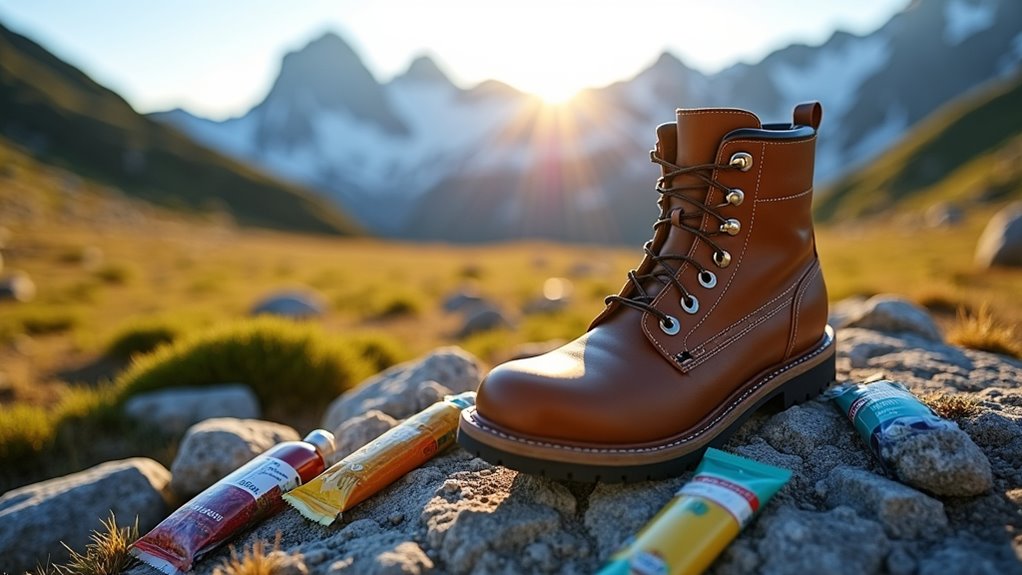
When you’re planning extended hikes, proper nutrition and hydration become critical survival factors that can make or break your outdoor adventure. You’ll need approximately one liter of water per two hours of moderate hiking, plus extra for emergencies. Pack high-energy foods like nuts, dried fruits, energy bars, and jerky that won’t spoil in your backpack.
Don’t rely solely on natural water sources – they’re unpredictable and may require purification. Bring water purification tablets or a portable filter as backup.
Calculate your food needs based on hiking duration, intensity, and weather conditions. Cold weather increases caloric requirements substantially.
Pack 20% more food and water than you think you’ll need. It’s better to carry extra weight than face dehydration or energy depletion miles from safety.
Similar principles apply to river rafting adventures, where proper meal planning and hydration strategies are equally essential for multi-day outdoor excursions.
Building your hiking skills gradually protects you from dangerous situations and builds the confidence you’ll need for challenging adventures. You’ll learn essential navigation, pacing, and safety techniques on forgiving terrain before facing serious risks. Easy trails let you test your gear, discover your physical limits, and develop problem-solving skills without life-threatening consequences.
Start small to stay safe—master navigation and gear on easy trails before tackling serious hiking challenges.
Start with local nature walks, then progress to day hikes with moderate elevation gain. Each successful outing teaches valuable lessons about weather changes, terrain conditions, and your body’s responses to exertion. Remember that proper preparation and gradual skill development are among the most essential tips for ensuring your hiking adventures remain safe and enjoyable.
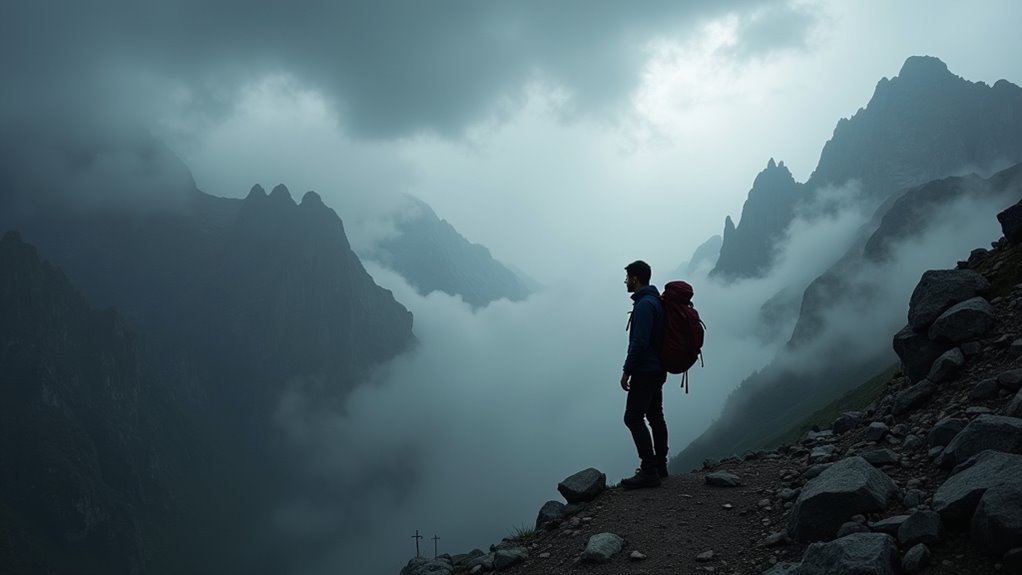
Although your excitement might push you to continue, learning to recognize warning signs and retreat when necessary could save your life on the trail. Your gut feelings about dangerous situations are usually right, so don’t ignore them.
If weather conditions deteriorate rapidly, you’re feeling unusually fatigued, or terrain becomes more challenging than anticipated, it’s time to head back.
Watch for physical warning signs like dizziness, nausea, or persistent pain. Mental fatigue can impair judgment, making you prone to poor decisions.
You’ll also want to turn around if you’re running behind schedule or approaching darkness without proper lighting. Before heading out, ensure your hiking bag contains all the essential items that could prove crucial during unexpected situations or emergency retreats.
While cell phones provide convenient communication, you can’t rely on them alone during hiking emergencies. Mountain terrain, dense forests, and remote locations often block cellular signals when you need help most. That’s why carrying backup communication and signaling devices becomes essential for solo hikers.
Consider investing in a satellite communicator or personal locator beacon for true emergency situations. These devices work anywhere and can send your exact coordinates to rescue teams.
Don’t forget traditional signaling methods either – they’re reliable and don’t require batteries.
Just as church camp experiences create lasting bonds through shared outdoor challenges, having reliable communication tools ensures you stay connected to safety networks during your wilderness adventures.
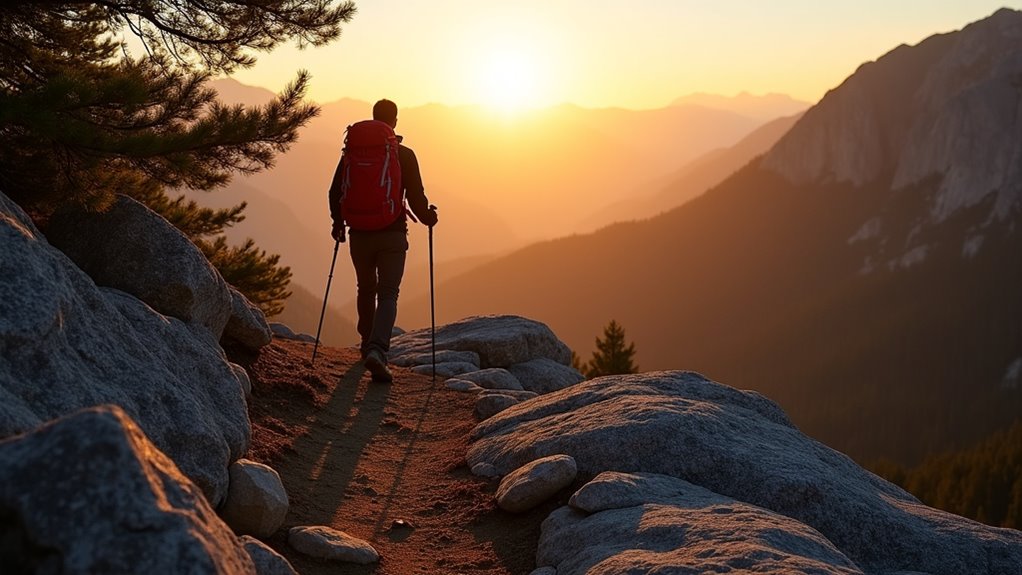
Even experienced hikers can underestimate how quickly daylight fades, especially during shorter winter days or when thick forest canopy blocks available light. You’ll want to start your hike early enough to finish well before sunset.
Calculate your return time by considering your pace, trail difficulty, and planned stops. Don’t forget that hiking downhill in darkness is particularly dangerous due to loose rocks and uneven terrain.
Always check sunset times before heading out and add a safety buffer of at least one hour. If you’re hiking in mountainous areas, remember that valleys lose light much faster than peaks.
Weather changes can also reduce visibility quickly. Pack a reliable headlamp and extra batteries as backup, but never plan to rely on them for your primary hiking time.
Extended hiking and scrambling over rough terrain can leave your hands raw and tender, so consider preparing your skin for climbing conditions you might encounter on challenging mountain routes.
When you’re exploring nature’s beauty, you become a temporary guest in the home of countless plants and animals. Your responsibility extends beyond personal safety to preserving these wild spaces for future adventurers.
Pack out everything you bring in, including food scraps and biodegradable items. Stay on designated trails to prevent erosion and protect fragile vegetation.
If you encounter wildlife, maintain respectful distance and never feed animals – it disrupts their natural behaviors and can create dangerous situations.
You’ll help preserve wilderness integrity while ensuring safe, enjoyable experiences for everyone. Following these responsible camping principles ensures that wilderness areas remain pristine and accessible for generations of outdoor enthusiasts to come.
You’ve got the roadmap to transform your solo hiking dreams into safe reality. Think of preparation as your invisible hiking buddy—it’ll never let you down when the trail gets tough. Don’t let fear clip your wings; instead, let smart planning be the wind beneath them. Pack your confidence alongside your compass, trust your gut when storms brew, and remember that the mountains reward those who respect their power.